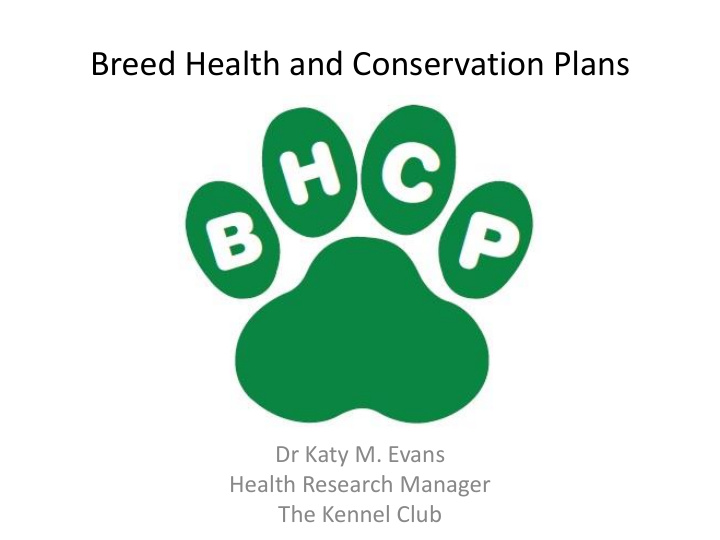



Breed Health and Conservation Plans Dr Katy M. Evans Health Research Manager The Kennel Club
Who am I? • Vet – qualified 2001 (Bristol) • Various clinical jobs, before focussing on inherited conditions in dogs since 2007 • Funded by KCCT (at AHT) from 2007-2010 • Analysed data from 2004 Purebred Dog Health Survey • Undertook breed-specific health surveys • MSc in Veterinary Epidemiology and Public Health (2010, RVC)
PhD – “Genetic evaluation of guide dogs in the UK” • Identification of selection aims • Population structure analysis • Estimation of heritability of numerous health and behavioural traits affecting their main breeds/cross • Collaborative prioritisation of heritable traits • Implementation of EBVs and behavioural selection index for traits of most importance
2017 2001
Breed Health and Conservation Plans • Project launched September 2016 • Eventually every breed will have their own bespoke plan • 17 breeds in first round, coming to completion now • 30 breeds in round 2, round 3 breeds still being decided • Led by the Kennel Club, but breed clubs are key collaborators as are other external stakeholders
Breed Health and Conservation Plans
Main sources of evidence 1 • Review of scientific literature • Kennel Club’s 2004 & 2014 Purebred/Pedigree Dog Health Surveys • Kennel Club’s registration data and population analysis • Breed Watch information and Judges’ Health Monitoring (for category three breeds) • VetCompass data (if available)
Main sources of evidence 2 • Insurance data • Breed club health survey data and data from breed club health initiatives • Data from BVA/KC Health Schemes and KC-recognised DNA tests • Breed Health Coordinator’s Annual Health Report • Information relating to current research projects involving the breed
The blind men and the elephant
Literature review • Lays out the current scientific knowledge relating to the health of the breed • Referring primarily to research which has been published in peer-reviewed scientific journals • Possible limitations of studies acknowledged • Small sample size • Bias (e.g. hospital population) • Non-UK populations • Old study Photo courtesy of Mr. A. McIlroy
Purebred/Pedigree Dog Health Surveys • Summary of morbidity and mortality results for the breed from 2004 and 2014 Kennel Club surveys • For 41 breeds with more than 200 responses in 2014 survey, an indication of which conditions appear more or less prevalent in this breed compared to the all-breed prevalence
VetCompass results • Some fortunate breeds have their own breed-specific VetCompass study • Requires more than 1000 individuals of the breed, so breed- specific studies not possible for many breeds • Condition-specific studies also provide lots of useful information
VetCompass results 2
Insurance data • Data available from Agria UK for all breeds • Most frequent reasons for claims (on full policies and free puppy policies) in the past 12 months • Some breeds also Swedish Agria data
Breed-specific health surveys • Availability variable • Some breeds have undertaken several surveys themselves • For low number breeds in particular these can be a very valuable source of information • We can offer some help
Visual health check reports / judges’ health monitoring • For Breed Watch category 2 and 3 breeds • Can give an indication of progress on conformational concerns
Breed Club health activities • Details of breed club health activities • Breed Health Coordinator? • Breed Health Committee? • Health website or website section? • Breed health schemes? • Breed club breeding recommendations?
BHC annual report ‘Please list and rank the three health and welfare conditions that the breed considers to be currently the most important to deal with in your breed’ • What were the three conditions? • Have they changed since the year before? • What actions has the breed been taking to address these?
DNA test results • What DNA tests are available for the breed • Results of any Official DNA tests • For these, numbers and proportion of clear, carrier, affected
BVA/KC Canine Health Schemes • Which schemes are mandatory requirements or recommendations for ABS members? • Numbers of participating dogs and results received • For BVA/KC/ISDS Eye Scheme: • Schedule A breeds have numbers affected and unaffected • All breeds have “Sightings reports” in which non - Schedule A conditions are recorded
Genetic diversity measures • Registration statistics • Results of 2014 population analysis • Effective population size • Current breed average inbreeding coefficient • Evidence of use of ‘popular sires’?
Registration statistics
Effective population size – estimated from observed rate of inbreeding
Evidence of use of ‘popular sires’
Current research projects • Is the breed participating in any current research projects? • UK projects especially, although others noted • E.g. Give a Dog a Genome
Evidence base completed – what next? • Sent to Breed Health Coordinator / Breed Health Committee • Meeting arranged to discuss • Priorities and actions agreed • Review date agreed
Priorities and actions • Will vary hugely from breed to breed • Do we need more data? • Is further research necessary? • Is further education necessary? • Of puppy buyers? • Of owners and breeders? • Of judges?
Thank you for listening! Any questions?
Recommend
More recommend